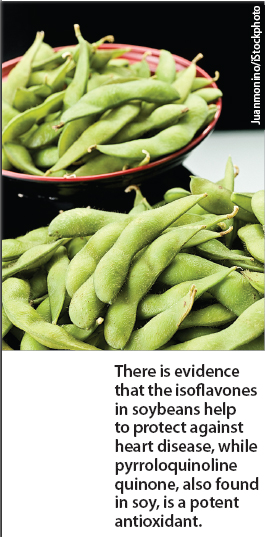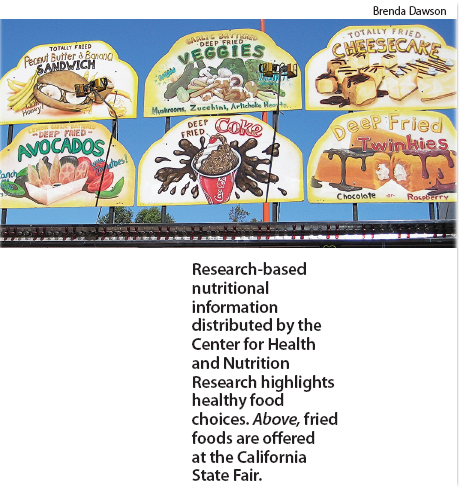All Issues
Biofactors in food linked to health benefits
Publication Information
California Agriculture 65(3):104-105.
Published July 01, 2011
PDF | Citation | Permissions
Full text
Can what we eat help fix what ails us? Research increasingly suggests that the answer could be “yes.” Many foods contain biofactors — biologically active compounds — that may prevent and treat illnesses including asthma, diabetes and heart disease, according to new studies from the Center for Health and Nutrition Research (CHNR) at UC Davis.
Established in 2006, CHNR was initially supported by the Vitamin Case Consumer Settlement fund. In this antitrust case, vitamin manufacturers controlling 80% of the world market were found guilty of international price fixing. CHNR received $6.4 million from the resulting settlement fund over 4 years and allocated most of it to innovative pilot research on the role of California's fruits, vegetables and nuts in preventing chronic diseases. More than one-third of the 33 pilot projects have already been awarded additional grants.
“Our goal was to leverage the settlement funding to make a much larger impact on improving health in California,” says CHNR co-director Carl Keen, a UC Davis nutrition professor. “There's been tremendous research under the vitamin settlement.” One key to CHNR's success is that the projects were multidisciplinary, fostering collaboration across academic departments.
“The research went from the cellular level all the way to applications to human health, to the great benefit of the Center,” says CHNR administrator Sheri Zidenberg-Cherr, a UC Davis Cooperative Extension nutrition specialist. This comprehensive approach is critical to identifying the health benefits of particular nutrients, which can be hard to pin down.
Findings from CHNR projects have been incorporated into the research-based nutrition information and guidelines that are disseminated through the CHNR website. These include Nutrition Bites, which provide targeted information on selected foods and phytochemicals, and Nutrition Fact Sheets, which provide up-to-date information on controversial research on health and phytochemicals (biofactors in plant-based foods) to the general public as well as health professionals.
Micronutrients and biofactors
The CHNR pilot projects focused on how micronutrients, biofactors and phytochemicals can help reduce the risk of chronic diseases. Micronutrients include vitamins and minerals, and one CHNR project shows that slender female athletes are particularly at risk for low bone mass and so require diets higher in calcium and other nutrients ( page 124 ).
Biofactors are compounds in our food that affect us at the biochemical level and may ultimately benefit our health. For example, the omega-3 fatty acids in foods such as walnuts, flax seeds and salmon may protect against a range of diseases associated with inflammation, including asthma and the hypertension-related inflammation that can damage kidneys. CHNR research suggests that omega-3 fatty acids could reduce asthma symptoms ( page 112 ) as well as kidney damage ( page 106 ).
Other research at the Western Human Nutrition Research Center, at UC Davis, shows that tangerines can lessen vitamin A deficiencies common in developing countries, which can cause blindness ( page 130 ).
Phytochemicals and health
Epidemiological studies link particular diets to less risk of chronic diseases. Notably, the traditional Mediterranean diet — mostly vegetables, fruits and whole grains, with moderate amounts of nuts, olive oil and red wine — is associated with lower rates of heart disease, cancer, and Parkinson's and Alzheimer's diseases.
However, it has yet to be firmly established that specific phytochemicals in our diets can protect against diseases. Nutritionists therefore advise eating a wide variety of plant-based foods rather than taking phytochemical supplements.
That said, a number of phytochemicals do show promise in protecting against and even treating chronic diseases. For example, CHNR research shows that soybeans contain estrogenlike compounds called isoflavones that may protect against heart disease ( page 118 ), and that phytochemicals in olive oil and red wine may protect against heart disease and diabetes ( pages 136 and 141 ).
There is evidence that the isoflavones in soybeans help to protect against heart disease, while pyrroloquinoline quinone, also found in soy, is a potent antioxidant.
Mitochondrial nutrients and aging
The Mediterranean diet is rich in phytochemicals that boost mitochondria (organelles in our cells that convert glucose and other nutrients into energy) and so are known as mitochondrial nutrients. When mitochondria are scarce or have genetic defects that keep them from working properly, this can generate toxic metabolites and damaging free radicals.
“Mitochondria are central to aging,” says UC Irvine biochemist Edward Sharman. “Improving their function may modulate or delay the onset of diseases related to aging, such as type 2 diabetes and age-related macular degeneration [vision decline].” Mitochondrial dysfunction also plays a key role in chronic illnesses such as heart disease and the inflammation contributing to arthritis, type 2 diabetes and other diseases.
One of the most promising mitochondrial nutrients is hydroxytyrosol, which is abundant in the extra-virgin olive oil that provides most of the fat in the traditional Mediterranean diet. Moreover, the red wine that is integral to the Mediterranean diet also increases hydroxy tyro sol levels, even though it contains relatively small amounts of this phytochemical. “Alcohol induces the body to produce more hydroxytyrosol,” Sharman says.
Using cultured fat cells as a model of age-related macular degeneration, Sharman and his collaborators found that hydroxytyrosol increases the number of mitochondria, thereby enhancing the function of these energy-producing organelles. “Hydroxytyrosol could ameliorate many age-related diseases,” Sharman says. The team also found that a combination of four mitochondrial nutrients improves liver and immune function in diabetic rats.
A new essential nutrient?
Another promising mitochondrial nutrient is pyrroloquinoline quinone (PQQ), which was first found in nitrogen-fixing soil bacteria and is now known to be ubiquitous ( page 141 ). “We're exposed to PQQ all the time at low levels,” says CHNR co-director Robert Rucker, UC Davis nutrition professor. “It can be derived from amino acids found in stellar dust, and stellar dust is what the earth is made of.” While Escherichia coli and other common gut bacteria do not make PQQ, soil bacteria provide it to plants in our diet. Good sources include fermented soybeans, wine, tea and cocoa.
Animal studies show that PQQ affects health markedly. Rucker and his colleagues found that depriving rats of PQQ compromised their immune systems and retarded their growth and reproductive rates. In contrast, restoring PQQ to their diets reversed these effects and returned them to good health. Moreover, PQQ stimulated nerve growth and counteracted aging in cultured cells.
How does this biofactor work? Rucker and his colleagues found that, like hydroxytyrosol, PQQ increases the number of mitochondria in cells. “It's also an extremely good antioxidant and anti-inflammatory agent,” he says. “It decreases C-reactive protein, which is an anti-inflammatory marker that is high in, for example, rheumatoid arthritis.”
For all that, it is not clear whether or not PQQ is an essential nutrient — those that our bodies require but do not make, including vitamins, minerals, and some fatty acids and amino acids. “It's hard to say if PQQ is essential,” Rucker says. This is because even though it is clearly beneficial, other nutrients may play the same roles.
“There are dozens of compounds identified in the diet that have biological impacts, and many of them do multiple things,” Rucker says. “The question becomes relative: is PQQ more important than other biofactors with similar actions?”
Personalized medicine
Understanding what biofactors do in our bodies could ultimately lead to personalized medicine, where nutrition-based treatments are tailored to the particulars of each person's biochemistry. This individual variation at the biochemical level may help explain the inconsistent outcomes of research on omega-3 fatty acids and inflammation.
“The studies are mixed,” says UC Davis pulmonologist Nicolas Kenyon. “Some have shown little effect, and others have shown that omega-3 fatty acids can reduce arthritis and blood vessel inflammation.”
Another factor is that different omega-3 fatty acids have different effects in the body. In a study of a mouse model of asthma led by Gertrud Schuster, UC Davis nutrition assistant project scientist, airway inflammation was reduced by one omega-3 fatty acid (eicosapentaenoic acid, or EPA) but not by another (docosahexaenoic acid, or DHA).
Research-based nutritional information distributed by the Center for Health and Nutrition Research highlights healthy food choices. Above, fried foods are offered at the California State Fair.
Asthma can be caused by multiple biochemical pathways, which are series of chemical reactions in our cells that metabolize compounds into other products. One pathway leading to asthma may be counteracted by the omega-3 fatty acids in fish oil, and this pathway may be more active in some patients than in others. To identify those likely to benefit from treatment with omega-3 fatty acid, Kenyon and his collaborators are genotyping asthma patients ( page 106 ). “We're looking for patients with high inflammatory mediators in this pathway,” he says. “There are going to be subgroups that do really well with fish oil and others that do not.”
This genotyping is targeted to DNA sequences associated with asthma and so is not comprehensive. “Some people are nervous about genome-wide analysis, which is scary because none of us is perfect,” Kenyon says. “But people are more interested when the focus is specific screening that could increase their chances of treatment.”
While all the vitamin settlement funds have now been disbursed, the advances and additional funding resulting from these pilot grants motivate the CHNR administrators to continue their work. “Our intent is to keep things running. We have the infrastructure to facilitate pilot projects that can attract larger grants,” CHNR co-director Keen says. “This represents what we need to do for agriculture in California: we need to be adventurous about getting new resources into research and out into the community.”






